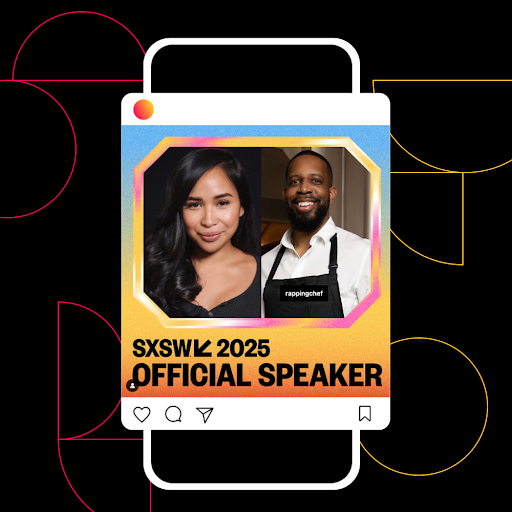‘If it doesn’t leave the platform, it’s not truly viral.’
It’s a bold statement that cuts to the heart of a major misconception. Social media virality isn’t just about big numbers on a single post. True virality spills over to other platforms. It shapes culture. It jumps from TikTok to X, from Instagram to Spotify. It gets screenshotted, stitched, memed, covered by newsrooms, and debated in group chats. It influences what we buy, how we talk, and even what we believe.
This phenomenon was explored at SXSW 2025 by Richelle Batuigas, VP of Business Intelligence & Data Strategy at Viral Nation, and Josh Williford, better known as The Rapping Chef. Their session, The Science of Virality: How Analytics Drive Dynamic Content explored their thesis that virality isn’t magic - it’s measurable. And it can be reverse engineered.
Because here’s the truth: Virality may feel like luck, but for brands, it’s almost always built on intentional decisions. Decisions informed by data.
Take the now-iconic ‘demure’ trend, sparked by creator Jools Lebron. This moment generated 2 million online mentions, sparked over 500K TikTok posts, 300K Instagram posts, and even earned the title of Word of the Year from Dictionary.com. This wasn’t just a moment, it was a cultural ripple effect. And brands who missed it didn’t just miss views, they missed relevance.
This is why ‘going viral’ matters more than ever. For brands, virality isn't just about visibility. It's a gateway to credibility, monetization, and long-term brand equity. But without the right signals, even standout content can get lost in the scroll.
So, how do you capture lightning in a bottle? Let’s unpack that.
Why Brands Keep Missing the Moment
Most brands still worship vanity metrics. They optimize for impressions hoping for impact, boost reach for resonance, and track CTRs, then wonder why nothing sticks. But virality isn’t about being seen. It’s about being shared. And most of the time, the metrics we rely on can’t explain why some content explodes while others vanish without a trace. The subtlety of emotional signals, creator behavior, or platform mechanics lies between the spaces of numbers and percentages on a dashboard.
As Richelle Batuigas explained during her SXSW session, “trends emerge so quickly that humans can't catch them in real time.” Her team mapped hundreds of viral moments and found the same pattern every time: content spikes on Day 1, begins declining by Day 5, and flatlines by Day 30. “It's incredibly important you join the conversation if possible within the first five days,” she said, underscoring how narrow the window is for brands to act.
Even creators misread the moment. Josh Williford (The Rapping Chef) initially expected his rap recipes to hit hardest. But it was his off-key singing that drove millions of views. Why? Because it landed emotionally. “My engagement is significantly higher when I'm singing,” Josh said. “Those videos almost always get millions of views.” He wasn’t just guessing; he saw it in the analytics and felt it in the replies. “I read a lot of DMs because I wanna know what you guys wanna see. What recipe should I make? What song should I play?”
The takeaway: Josh didn’t go viral by polishing to perfection, but by listening intently to his community. By doing this, he transformed DMs into direction and comments into content cues. While brands wait for dashboards to tell them what worked, creators are iterating on audience feedback in real-time.
This real-time adaptation is what separates viral creators from lagging brands. Josh treats his comment section like a focus group. Brands, on the other hand, still over-index on dashboards. But dashboards rarely reflect the deeper dynamics at play.
According to a meta-analysis Richelle’s team ran, the content that performed best wasn’t the most polished—it was the most human. Influencer content that scored highly on four key attributes consistently delivered better brand outcomes:
|
Attribute |
Outcome |
Why |
|
Authenticity |
Increased brand likability |
People trust real. When it feels unscripted, it feels honest, and honesty sells. |
|
Relatability |
Boosts brand recall |
When your audience sees themselves in the content, they remember your brand longer. |
|
Credibility |
Higher likelihood of purchase |
Not everyone is an expert, but the right voice can make your message believable and buyable. |
|
Realism |
Captures attention |
High-gloss is scrollable. Real-world moments are scroll-stoppers. |
These metrics directly shape how audiences respond, remember, and react to content. Yet despite that evidence, most brands still ‘hit and hope’ or, as Richelle said, “They post, they boost, and they wait and then wonder why it didn’t catch on.”
Until brands learn to read emotional signals, adapt fast, and experiment like creators, they’ll keep missing the moment and the momentum that comes with it.
The Formula: Emotion + Analytics
If virality feels unpredictable, that’s because most people are only looking at half the picture. The truth is, viral content lives at the intersection of emotional connection and analytical precision. Emotion starts the spark—data fans the flame.
Richelle Batuigas framed it clearly: “Virality really is a balanced blend between art and science. You need creativity to meet data to take a single moment and allow it to have mass resonance and scale.” Emotional cues are what ignite shares, tags, and rewatches. But without the structure to amplify them, even the best content can fade before it ever catches fire.
Just ask Peloton. The controversial ‘Peloton Wife’ ad sparked outrage, memes, and late-night parodies. But without a strategic response from Peloton, the conversation slipped through their fingers. The viral moment burned red hot, then died cold. Now contrast that with Ryan Reynolds’ Aviation Gin. They seized the moment, casting the same actress in a brilliant parody ad that transformed controversy into brand affection. One brand let the spark die. The other threw gasoline on it, and won.
Josh Williford learned that firsthand. “I did a parody to a popular song and made a spicy rigatoni video to a Frank Ocean song,” he said. That video didn’t just perform well, it triggered a wave of recreations from celebrities like Tia Mowry and Monet McMichael. But it wasn’t luck. It was the product of listening closely to what resonated with his audience.
Josh didn’t just track views; he read the comments. He responded to DMs. He spotted patterns in what people loved and doubled down. That kind of creative intelligence, where qualitative feedback guides creative decisions, is something more brands need to adopt. As Richelle said, “You need the mindsets of artists and analysts to be able to understand the balance of art versus science and how you align moments to your brand.”
Lucky for marketers, viral content follows recognizable patterns. Parodies and comedic sketches often drive the widest reach by evoking high-arousal emotions like laughter. Emotional storytelling yields longer watch time and deeper engagement. Even ASMR, though less shareable, builds intense loyalty within niche audiences.
The takeaway: Each platform plays by different rules. TikTok rewards rewatches and shares. Instagram favors dwell time. YouTube loves retention. If your brand isn't designing content with platform-specific signals in mind, you're not playing to win, you're playing to participate.
How to Build a Culture of Experimentation
Most brands don’t lack content. They lack a system for learning.
Campaigns are launched, assets are approved, metrics are tracked, but few teams pause to ask: What did we learn? What are we afraid to try? What should we try next? What’s worth doing again but faster?
Building a culture of experimentation means moving from reactive content planning to proactive iteration. It requires structure, shared language, and a repeatable framework that helps brands uncover what’s working and double down on it while it’s still relevant.
Here’s how to operationalize experimentation:
- Identify: Clarify your content purpose, brand posture, and tolerance for creative risk. Is your goal to shape conversations or respond to them? Are you positioned to lead with original moments or amplify what’s already gaining traction? Locking in these guardrails upfront ensures alignment across creative, strategy, and media teams and enables faster decisions when a real-time opportunity appears.
- Design: Establish a layered measurement system tied to clear business outcomes. Define your primary metric (e.g., qualified traffic, view-through rate), pair it with a secondary measure of quality (e.g., brand sentiment, creator affinity), and add a tertiary diagnostic layer (e.g., thematic analysis, share triggers, comment velocity). Use this structure to build a learning agenda that guides not just what you measure, but when and how you interpret results.
- Experiment: Implement dual-speed testing. On one track, monitor always-on signals—engagement shifts, format trends, creator benchmarks—at a daily or hourly resolution. On the second, run controlled experiments designed to answer strategic questions: Which format drives recall? Which creator moves sentiment? Which tone outperforms at each funnel stage? Tag every asset with its hypothesis and map learnings across content types and audience segments.
- Adapt: Build feedback loops into every content sprint. Codify learnings into playbooks and briefing docs. Run structured debriefs across both top and bottom-performing assets. Track comment themes, remix behaviours, and audience sentiment as critical performance data, not qualitative extras. Integrate insights into planning cycles so they’re acted on while still relevant.
The takeaway for marketers is clear: consistent experimentation isn’t about getting lucky—it’s about stacking insights. Richelle’s research echoes this: “The highest-performing teams treat every piece of content as an experiment.”
Don’t Chase Virality, Design for It!
The takeaway is clear: virality isn’t guesswork, and it’s not a one-time win. It’s the outcome of disciplined systems made up of fast feedback loops, structured experimentation, and community teams that know how to transform cultural signals into strategic advantage.
But to make that repeatable, brands need more than a viral hit—they need infrastructure. Insight isn’t just something you capture at the end of a campaign. It has to be built into every phase of content development, from creative briefing to post-launch refinement.
That’s where Viral Nation comes in.
We help brands build the backbone of modern social media marketing: advanced analytics, emotional signal tracking, cross-platform attribution, and creator-first frameworks. This isn’t reporting after the fact. It’s real-time insights that power real-time relevance.
Because with us, you don’t just launch campaigns—you build momentum. You test faster. Learn quicker. Adapt smarter. And repeat what works, before everyone else even figures out why it worked.




.png?width=300&height=300&name=Minimal%20Photocentric%20Productivity%20Blog%20Banner%20(3).png)
